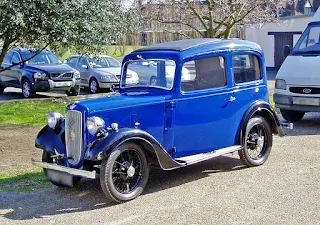Until the First World War Austin built mainly large cars, but in 1909 they sold a single-cylinder small car built by Swift of Coventry called the Austin 7 hp. After this they returned to bigger cars.
In 1920 Sir Herbert Austin commenced working on the concept of a smaller car, mainly to meet the needs of young families aspiring to own an affordable motor car. This idea was spurred on by the introduction of the Horsepower Tax in 1921. His design concept marked a departure from his company's conservative motoring past and Austin received considerable opposition from his board of directors and creditors. Because the company was in receivership Austin decided to carry out the project himself on his own account and in 1921 hired an 18-year-old draughtsman, Stanley Edge, from the Austin factory at Longbridge, Birmingham to aid in the drawing of detailed plans. This work was carried out in the billiard room of Austin's Lickey Grange home.
Edge convinced Austin to use a small four-cylinder engine. The original side valve engine design featured a capacity of 696cc ( 55mm x 77mm ) giving a RAC rating of 7.2 hp, the cast cylinder block featured a detachable head and was mounted on an aluminium crankcase. The crankshaft used one roller and two ball bearings and the big-ends were splash lubricated. Edge also carried out the design of other mechanical components such as the three speed gearbox and clutch assembly. Austin was largely responsible for styling the Seven's design, which was reportedly influenced by the design of the Peugeot Quadrilette. The "A" frame chassis design was believed to have been influenced by the design of an American truck used in the Longbridge factory in the early 1920s.
The design was completed in 1922 and three prototypes were constructed in a special area of the Longbridge factory, and announced to the public in July 1922. Austin had put a large amount of his own money into the design and patented many of its innovations in his own name. In return for his investment he was paid a royalty of two guineas (£2, 2s), (£2.10) on every car sold.
Nearly 2,500 cars were made in the first year of production (1923), not as many as hoped, but within a few years the "big car in miniature" had wiped out the cyclecar industry and transformed the fortunes of the Austin Motor Co. By 1939 when production finally ended, 290,000 cars and vans had been made.



























No comments:
Post a Comment